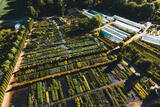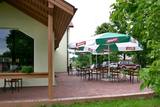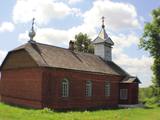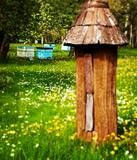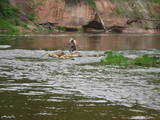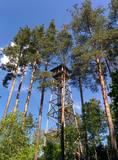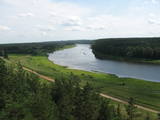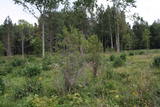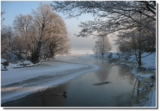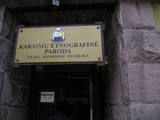| Nr | Name | Beschreibung |
|---|---|---|
|
Eine der reichhaltigsten Baumschulen in Lettland, die zudem auch noch reich mit natürlicher Schönheit gesegnet ist. Hier werden über 1000 verschiedene Arten, Sorten und Formen angeboten. Führungen durch Laub- und Nadelbäume, Ziersträucher, Hecken, Kletterpflanzen, besonders gepfropfte Bäume und Sträucher, die man allesamt auch kaufen kann. Ein sehenswertes Dendrarium (Schaugarten), Beratungen. |
||
|
Das Café befindet sich im Zentrum von Dundaga, im Gästehaus Krūziņi. Lettische Küche: Sauerkrautsuppe, graue Erbsen mit Sauermilch, gebratene Flunder oder gebratener Kabeljau, Sauersuppe mit Kartoffeln. Das besondere Gericht : Turm aus Quark oder eine Creme aus den Produkten der Molkerei von Dundaga. |
||
|
Ģimenes uzņēmums Svētes pagastā, netālu no Jelgavas. Kopš 2019.gada šeit top dažādi Latvijas priežu produkti, kas vērtīgi kā imunitātei, tā arī veselībai. Mītavas Čiekurs produktu galvenā sastāvdaļa ir Parastā priede (Pinus sylvestris). Tā bagāta ar ēterisko eļļu, sveķiem, miecvielām, C vitamīnu u.c. vērtīgām vielām. Tiek gatavotas priežu čiekuru karameles, čiekuru sīrupa zefīri, želejkončas, priežu čiekuru zapte, karamelizēti čiekuri sīrupā, šokolādē, kā arī priežu pumpuru sīrups un tēja. Ekskursija norisinās 90-120 minūtes, kuru laikā atraktīvais saimnieks Reinis pastāstīs par uzņēmuma vēsturi, dalīsies receptēs, pagatavos katram apmeklētājam gardu dāvanu (čiekuru marmelādi), kā arī protams- varēs degustēst dažādos priežu produktus. Papildu pirms vai pēc ekskursijas iespējams ieturēties ar uz ugunskura gatavotu pupiņu zupu ar lauku kūpinājumiem, soļanku vai biešu zupu. Tūristus uzņem nupat uzbūvētajā ekskursiju telpā- Čiekurnīcā. Uzņemt var līdz pat 60 interesentiem reizē. |
||
|
This is the thickest and mightiest Norwegian spruce (Picea abies) in Latvia. Its monolithic trunk, with its small holes, is unusual. The tree is in the overgrown park of the former Īve Estate, behind the ruins of the mansion.
|
||
|
Taarka Tarõ Köögikõnõ befindet sich auf einem traditionellen Bauernhof der Setukesen. Dort werden neben den traditionellen Gerichten der Setukesen auch Gerichte anderer finno-ugrischen Völker sowie ukrainische Gerichte angeboten. |
||
|
Bоrisovas St. Nikolay Old-Believers Prayer House was built in the period of 1911 – 1921 . The different feature of the Prayer House is a brick building placed on the hill. The bell of the temple was specially
ordered and brought from St. Petersburg. The bell has a very soft sound.
|
||
|
In dem reizvoll gelegenen Hof, in dem die Landwirtschaft nach einer umweltfreundlichen Philosophie erfolgt, werden etwa 300 Bienenvölker gehalten. Zur Befriedigung der Bedürfnisse der Besucher gibt es einen Hofladen und einen Verkostungsraum. Auf dem Hof kann man Honig aus verschiedenen Blütentrachten kaufen, Pollen (als gesondertes Erzeugnis oder mit Honig vermischt), Propolis (als gesondertes Erzeugnis oder mit Honig vermischt), Bienenbrot, Wachskerzen und andere Souvenirs. Aug dem Hof werden Verkostungen veranstaltet, die auch Met umfassen, zudem gibt es Führungen. |
||
|
Kräuterhof Tamme beschäftigt sich mit Anbau von Kräutern und Heilpflanzen. Es gibt einen Mustergarten für die Besucher. Wir züchten verschiedene Gemüse- und kulinarische Zierpflanzen. Auf Vorbestellung gibt es Kräutertee und selbstgebackenes Kräuterpirogge. Im Hofladen gibt es vor Ort eingemachte Beeren, Gemüse, Kräuter- und Teemischungen und andere Kräuterprodukte. |
||
|
The owner of the venue makes homemade wine on the basis of traditions that have been handed down from generation to generation. You can taste four different wines along with snacks and engage in philosophical discussions about winemaking recipes. You can also buy the wines. |
||
|
Ģeoloģiskā taka sastāv no trīs saistītiem posmiem: „Melturi – Kārļu zivjaudzētava”, „Kārļu zivjaudzētava – Zvārtes iezis” un "Zvārtes iezis - Veclauču tilts". Amatas senleja veidojusies vienlaikus ar Gaujas senleju leduslaikmeta beigu posmā un pēcleduslaikmetā, ledāja kušanas ūdeņiem plūstot uz Gaujas ieleju. Gaujas NP teritorijā Amatas senielejas dziļums sasniedz 50 metrus un platums palielinās līdz apmēram 1-1,5km.
Augstas kraujas (vairāk ne kā 40 metru), kurās redzami augšdevona Pļaviņu svītas dolomītu un augšdevona Amatas un Gaujas svītu smilšakmeņu atsegumi, mijas ar mežiem apaugušām, 3-16m augstām stāvām terasēm.
Amatas senieleja ir nozīmīga ne tikai ar savām dabas ainavām. Tās krastus grezno dolomīta un smilšakmens atsegumi, kas atklāj zemes vēstures lappuses 350-400 miljonu gadu tālā pagātnē, kad Latvijas teritoriju klāja jūra.
Velobraucieniem taka nav piemērota!
|
||
|
Uzcelts apkaimes augstākajā vietā – Ančupānu meža kalnā, kuru vietējie dēvē par „Bāku”. No 26 m augstā torņa redzama ļoti plaša panorāma ar Rēzeknes pilsētas namiem, baznīcu torņiem un apkaimes mežu masīviem, kas mijas ar lauksaimniecībā izmantojamām zemēm. Blakus tornim – atpūtas vieta. |
||
|
1996. g. atklātais piemineklis (tēlniece: A. Veinbaha) Dagdā (starp Asūnes un Rēzeknes ielām) ir piemiņas vieta komunisma terora upuriem. No šejienes paveras labs skats uz salām bagāto Dagdas ezeru. |
||
|
Dieser Park ist einer der reichsten und ungewöhnlichsten Naturparks in Lettland in Bezug auf seine natürlichen Ressourcen, die umgebende Natur, die Landschaften, die biologische Vielfalt des Gebiets und seiner Kulturdenkmäler, die man hier findet. Der größte Schatz ist das kaum veränderte Daugava-Flusstal mit seinen acht großen Windungen auf einer Länge von vier bis acht Kilometern. Dort sind ebenfalls die Schluchten der Nebenflüsse. Einen besonders schönen Blick kann man von den Steilufern des Daugava - Flusstales werfen, besonders bei den Slutiški- und Ververi - Klippen und dem Elerne - Hügel. Es gibt mehr als 20 archäologische Denkmäler an den Ufern des Tales, uralte Burgberge in Najene, Markova, Vecračina usw., unzählige Kirchen – wie die Kirchen Juzefova, Sprukti, Borovka, Elerne, Sīķele, Kaplava und andere, die Gutshöfe Rozališki, Lielborne und andere, das einzigartige Altgläubigendorf Slutiški. Es gibt interessante Naturpfade und Fahrradrouten in diesem Gebiet. Man kann auf Pferden ausreiten und es gibt einen Aussichtsturm mit weiteren Möglichkeiten für Touristen. Die Daugava hinunter zu paddeln ist eine interessante Möglichkeit, seine Zeit zu verbringen.
|
||
|
One of few places in Latvia (around 1 km to the North from Lapmezciems) where used to be beautiful juniper meadows. Since no agriculture activity (grass cutting, cattle grazing) has been implemented in the area, juniper meadows are overgrowing and disappearing. To save the area sustainable management is needed. Slitere National Park with Blue Mountain cliff and Slitere lighthouse is located in short distance from Kadiku nora (Juniper meadow).
|
||
|
Saunahaus mit Kaminzimmer, Sauna, Dusche, Doppelschlafzimmer. Sommerhaus mit einem Zimmer mit zwei einzelnen Betten, Trockentoilette. |
||
|
Der Fluss Daugava ist der größte Fluss in Lettland und der Schicksalsfluss des lettischen Volkes. Schon nach dem Ende der Eiszeit reisten auf das heutige Gebiet von Lettland durch das Tal des Flusses Daugava die ersten Pflanzen und Tiere ein, denen Menschen folgten. Das ist der Grund, warum das Ufer des Flusses Daugava einer der ältesten von Menschen bewohnten Orte, sowie das mit Pflanzenarten reichte Gebiet in Lettland ist. Auch die Dichte der ausgezeichneten Kulturdenkmäler und der historischen Denkmäler ist ein Grund, warum die Ufer des Flusses Daugava so beliebt sind. Auf der Strecke Rīga – Jēkabpils kann man bequem die Eisenbahnlinie Rīga – Daugavpils benutzen. Weiter sind Bahnhöfe angezeigt, an denen es auszusteigen wert ist, und kleine – einige Stunden bis einen halben Tag lange – radiale Wanderungen mit der Rückkehr am Bahnhof zu unternehmen. Route information from Latvijas Lauku forums |
||
|
This is the most visually impressive drumlin field in the Baltic States, and it is close to the village of Tabivere. The drumlins were established by ice glaciers, and they point in the direction in which the ice moved long ago. In terms of their appearance, the drumlins resemble loaf-shaped hillocks. From their “backs,” there are lovely views of the local landscape and the lakes that are around the area. The visitor centre is in the village of Äksi.
|
||
|
Die Haupttätigkeit des Hofs liegt im Gartenbau: Tomaten, Äpfel, Birnen, Himbeeren, Erdbeeren usw. Im Frühling kann man den blühenden Obstgarten und die Himbeerplantage besichtigen, im Herbst kann man auch an der Ernte teilnehmen und die speziellen Tragetaschen für die Apfelernte und die Erntezüge ausprobieren. |
||
|
Starpiņupīte – eine künstlich
geschaffene Verbindung zwischen dem
Kaņieris und der Rigaer Bucht, wo
heutzutage der Wasserpegel vom See mit
erneuertem Schleusensystem gesteuert
wird.
|
||
|
Karaims are a small nation of Turkish decent who practise The Karaim religion which started developing around 8th century in Persia. Their language is still used in modern-day Lithuania. In the museum there are rooms not only dedicated to Lithuanian Karaite communities but also Poland's and Ukraine's. |
||
